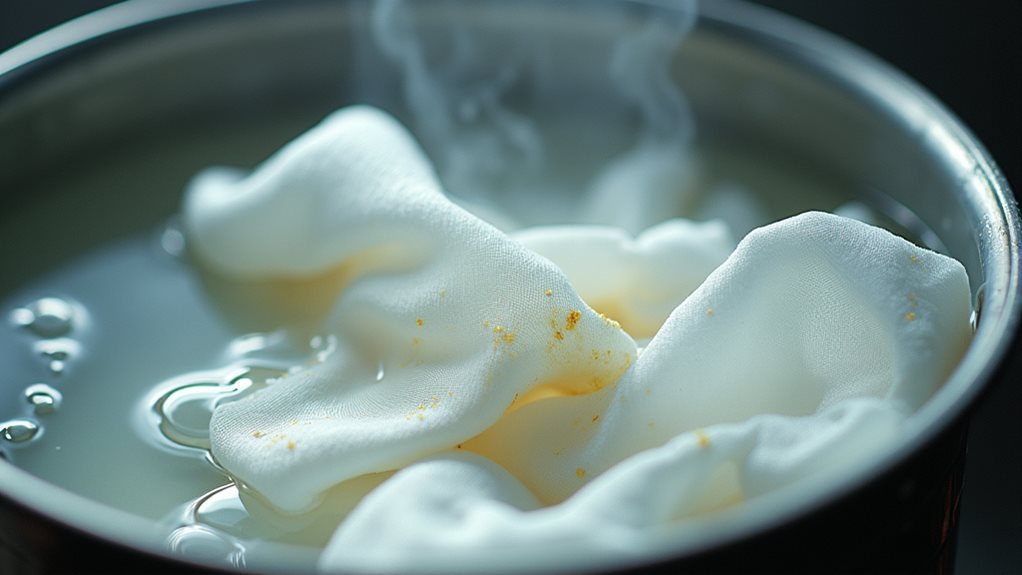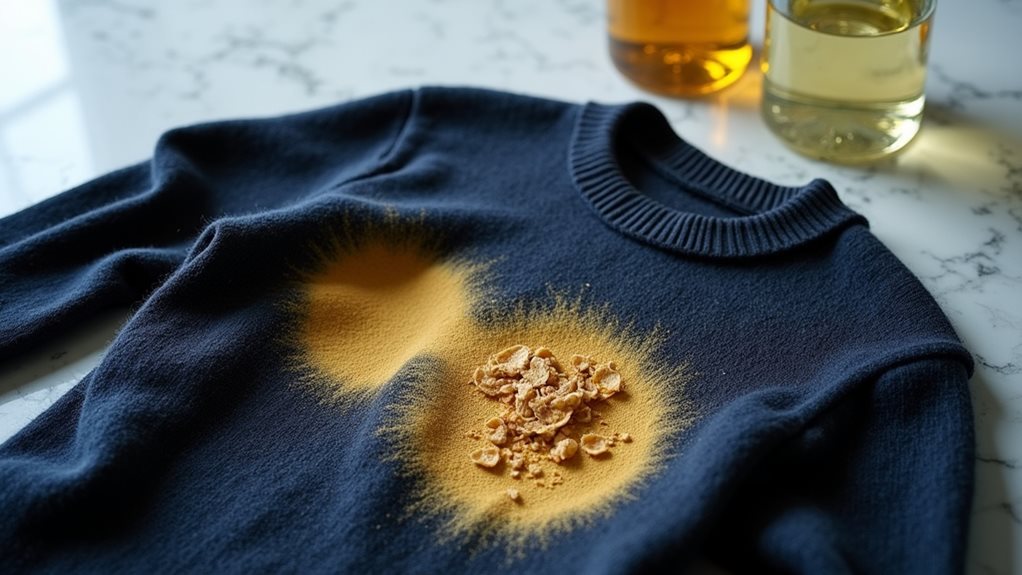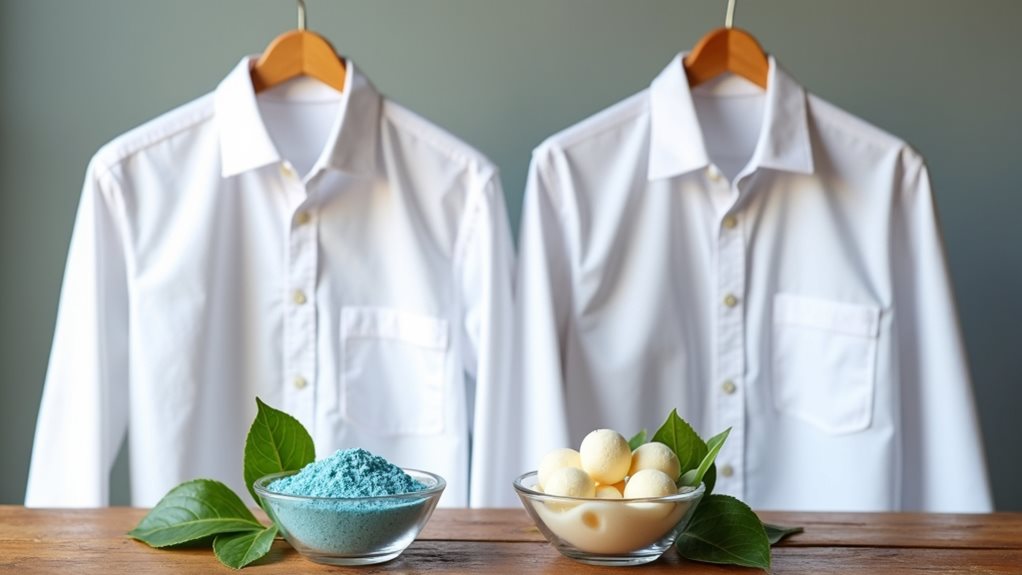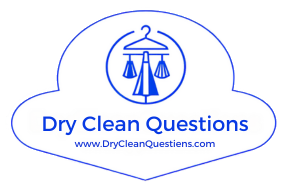Traditional dry cleaning can gradually damage your clothes through harsh chemical solvents like perchloroethylene, which weaken delicate fibers, fade colors, and leave potentially harmful residues over time. While it’s necessary for certain fabrics like silk and wool, many “dry clean only” items can actually survive gentle hand-washing or eco-friendly alternatives. You’ll notice signs of damage through unusual chemical smells, stiffness, or color loss after repeated treatments. Understanding when you truly need professional cleaning versus safer alternatives will help preserve both your wardrobe and health.
Understanding How Dry Cleaning Works
When I first started caring about my clothes beyond throwing everything into the washing machine, I’ll admit I was pretty clueless about what actually happens during dry cleaning – it seemed like some mysterious process where you drop off your fancy stuff and magic happens.
Turns out, dry cleaning services use chemical solvents, primarily perchloroethylene (PERC), instead of water to clean your garments. This cleaning method works brilliantly for delicate fabrics like silk and wool that would shrink or get damaged in regular wash cycles.
The process involves pre-treating stains, then immersing clothes in the solvent to remove stains effectively. After the solvent bath, garments go through drying and pressing to restore their original appearance. While the environmental impact has improved with closed-loop systems that recycle most solvents, understanding this process helps you make smarter choices about your garment care.
Common Fabric Damage From Dry Cleaning Processes

While dry cleaning seems like the safest choice for your favorite garments, the reality is that those chemical solvents can actually weaken delicate fibers in silk blouses and wool sweaters over time, leaving them fragile and prone to tears.
The high-heat pressing that follows cleaning adds another layer of stress to fabrics, which I learned the hard way when my cashmere cardigan came back noticeably smaller and misshapen after just one visit to the cleaners.
What’s particularly frustrating is how repeated treatments create a cycle of deterioration, where each cleaning session builds up chemical residue and gradually strips away the vibrant colors and soft textures that made you love those pieces in the first place.
The most concerning aspect is that perchloroethylene (PERC), the primary solvent used in traditional dry cleaning, not only damages your garments but can also leave harmful chemical residues that persist even after the cleaning process is complete.
Chemical Solvent Fiber Weakening
Although we trust dry cleaners to care for our most precious garments, the harsh reality is that the chemical solvents they use can slowly destroy the very fibers we’re trying to protect.
Perchloroethylene, or perc as it’s commonly called, acts like a microscopic bulldozer, gradually weakening your favorite fabrics with each cleaning cycle.
I’ve watched my grandmother’s silk blouse lose its lustrous sheen after multiple dry cleaning sessions, becoming brittle and lifeless despite our best intentions.
Wool sweaters, silk scarves, and acetate dresses are particularly vulnerable to this chemical assault, with repeated exposure creating cumulative damage that shortens your garment lifespan considerably.
Fortunately, many facilities are now adopting safer alternatives like wet cleaning, liquid CO2, and hydrocarbon solvents that are gentler on both fabrics and human health.
It’s heartbreaking when the solution becomes the problem 😔.
Heat Pressing Fabric Stress
Excessive heat weakens fibers over time, making your clothes more susceptible to tears and accelerated wear and tear.
Synthetic fabrics suffer even worse fates – polyester and nylon can literally melt under high temperatures, permanently altering your garment fit.
Think of it as giving your clothes an unwanted makeover they’ll never recover from, diminishing their lifespan with each pressing session.
The chemical solvents used in dry cleaning can also cause delicate fabrics to deteriorate and lose their natural texture with repeated treatments.
Repeated Treatment Deterioration
Like a favorite song played too many times on repeat, your beloved garments start losing their magic after countless trips to the dry cleaner, and honestly, it breaks my heart a little every time I see someone’s gorgeous silk blouse looking dull and lifeless.
Repeated dry cleaning creates a vicious cycle where delicate materials like wool and silk gradually lose their strength and natural luster, while chemical residues build up in the fibers like unwelcome houseguests who’ve overstayed their welcome.
You’ll notice fabric deterioration through subtle signs—pilling, fraying edges, and that dreaded fading and discoloration that makes your favorite pieces look tired.
The constant exposure weakens garment integrity, turning once-pristine clothing into shadows of their former selves.
Fortunately, many dry cleaners are now switching to safer alternatives like wet cleaning and hydrocarbon solvents that are gentler on fabrics than traditional perchloroethylene.
The Hidden Dangers of Perchloroethylene and Chemical Solvents

Beyond the visible damage to your favorite garments, there’s something far more concerning lurking in that fresh-from-the-cleaners smell – perchloroethylene, or PERC as it’s commonly known, which carries serious health risks that most people never consider when they’re simply trying to keep their work clothes pristine.
I learned this the hard way after years of dry cleaning my blazers weekly, only to discover that this chemical solvent doesn’t just vanish after cleaning but can linger on fabrics, releasing vapors in your closet and potentially exposing you to a probable carcinogen every time you get dressed.
What’s equally troubling is how PERC doesn’t just affect your personal health – it seeps into our soil and water systems, creating environmental damage that extends far beyond your wardrobe, making each dry cleaning decision a choice with broader consequences than you might realize.
The health concerns become particularly serious when PERC residues remain on clothes that haven’t been properly aired out, causing skin irritation and respiratory problems from direct contact with contaminated garments.
PERC Health Risks
How often do you pause to contemplate what invisible chemicals might be lurking in your freshly pressed blazer or favorite dress after a trip to the dry cleaner?
You’re probably thinking about looking sharp for that important meeting, not about toxic chemicals that could be affecting your health.
PERC, the most common solvent in dry cleaning, carries serious health concerns that’ll make you reconsider that quick wardrobe refresh.
This environmentally unfriendly carcinogen doesn’t just disappear after cleaning—it clings to your clothes like an unwelcome guest at a party 😬.
From headaches and dizziness to potential liver damage and reproductive issues, PERC exposure isn’t something you’d voluntarily sign up for, yet it’s happening every time you slip on those professionally cleaned garments.
The EPA has classified perchloroethylene as a probable human carcinogen, making this chemical solvent a particularly concerning choice for regular clothing care.
Solvent Environmental Impact
When I first learned that dry cleaning solvents don’t just magically vanish after doing their job, I felt like I’d discovered a dirty secret hiding in plain sight—these chemicals are quietly wreaking havoc on our planet in ways that would make any environmentally conscious person cringe.
PERC’s environmental impact extends far beyond the cleaning process itself, creating a cascade of problems that affect our air, water, and soil for years to come.
- Air pollution: PERC escapes through ventilation systems, persisting in outdoor air for weeks.
- Soil contamination: Improper disposal seeps into ground, threatening local ecosystems.
- Water safety: Groundwater contamination puts drinking water supplies at risk.
- Carcinogen exposure: Communities near facilities face increased health risks.
- Biodegradable alternatives: Safer cleaning methods like liquid silicone exist.
The health concerns have prompted the dry cleaning industry to transition toward safer alternatives like liquid CO2 and hydrocarbon solvents to reduce both environmental and human health risks.
When Dry Cleaning Is Necessary vs. When You Can Avoid It

Although I used to throw everything marked “dry clean only” straight to the cleaner without a second thought, I’ve learned that understanding which garments truly need professional care versus those you can safely handle at home will save you money, extend your clothes’ lifespan, and reduce your exposure to harsh chemicals.
You absolutely need dry cleaning for delicate fabrics like silk or velvet, and items with glued embellishments that water would destroy.
However, many dry-clean-only clothing pieces can actually survive gentle hand-washing or wet cleaning at home if you test first.
Skip the dry cleaning process for lightly soiled, durable items, but definitely seek environmentally friendly dry cleaners for oil-based stains or structured garments like suits that need professional expertise.
Dry cleaning uses chemical solvents instead of water to remove dirt and stains while preserving the fabric’s original shape, texture, and color integrity.
Signs Your Dry Cleaner May Be Harming Your Garments

Since I’ve learned the hard way that not all dry cleaners are created equal, I now pay close attention to warning signs that indicate my precious garments might be getting damaged rather than pampered.
Here are the red flags I’ve discovered through my own mishaps and research:
- Your clothes return with an unusual chemical smell – This often means dry cleaners use perchloroethylene or other harmful chemicals that leave residues.
- Fabrics feel stiff or look faded – Excessive heat damages delicate fabrics like silk and wool.
- Stains reappear or worsen – Poor pre-treatment techniques set stains permanently.
- Garments shrink or lose their shape – High temperatures weaken fibers during processing.
- Multiple negative reviews mention damaged items – Other customers’ experiences reveal patterns of poor garment care.
These chemical residues from traditional solvents like PERC can also pose health risks when you wear freshly cleaned garments without allowing them to air out properly.
Trust your instincts when something feels off about your dry cleaner’s practices.
Safer Alternatives to Traditional Dry Cleaning Methods

After discovering that my favorite silk blouse had been practically murdered by harsh chemicals at my old dry cleaner, I became determined to find gentler ways to care for my delicate garments without sacrificing cleanliness or convenience.
Now I swear by eco-friendly dry cleaning services that use liquid silicone instead of harsh solvents—it’s biodegradable and won’t assault your fabrics like traditional chemicals do.
For home care, I’ve mastered hand-washing techniques for supposedly “dry clean only” items, and honestly, most silk and wool pieces handle gentle home washing techniques beautifully.
At-home dry cleaning kits work wonders for quick refreshes, while steam cleaning eliminates odors without any chemicals whatsoever.
Your clothes will thank you! 🙌
Protecting Your Clothes While Minimizing Dry Cleaning Frequency

While I used to drag everything to the dry cleaner at the first hint of wear, I’ve learned that protecting your clothes means being strategic about when they actually need professional cleaning—and honestly, most garments can go much longer between visits than you’d think.
Smart prevention saves both money and fabric integrity, since excessive dry cleaning can actually weaken fibers over time:
- Spot-treat stains immediately using gentle home methods before they set permanently
- Layer washable undergarments beneath dry-clean-only pieces to absorb sweat and oils
- Air out delicate items regularly and use light steaming to refresh between wears
- Create a rotation system so pieces rest between uses, reducing frequency needs
- Reserve professional cleaning for truly soiled items or special occasions only
This approach minimizes fabric damage while keeping your wardrobe fresh.




